There’s something about the idea of a trip to a national park that just screams summer road trip destination. With the lush landscapes, abundant wildlife, and seemingly outdoor activities, summer spent in a national park is an experience like none other.
During the winter, national parks seem to take on whole new identities. The landscapes are a little more bare, yet no less beautiful, and while there are far fewer animals, the list of potential activities is still as seemingly endless. If you’re in need of a getaway to nature this winter, consider any of the parks we’ve included on this list, as they’re the 15 best national parks to visit during the winter.
Acadia National Park
Maine
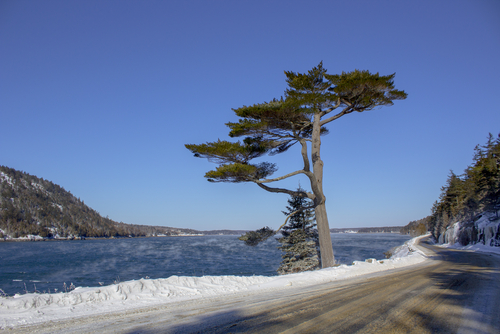
As popular as Acadia National Park is during the summer months, very few people venture way up here to Maine during the winter. If you do, you’ll have this stunning winter paradise practically to yourself. You can traverse the terrain via dog sled, snowshoe or ski through the backcountry, ice fish, and head out on scenic drives in and around some of America’s most beautiful scenery. If you’re lucky, you may spot foxes and other winter animals as they leave their dens to hunt.
Big Bend National Park
Texas
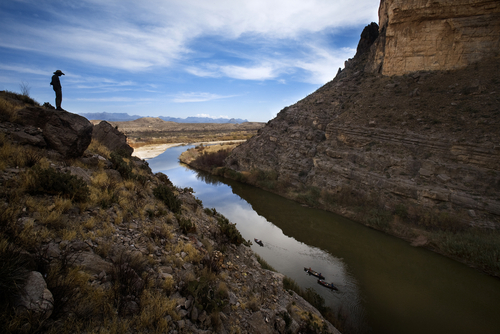
Perhaps the biggest difference between Big Bend National Park in the summer and Big Bend in the winter is the temperature. Whereas temps during the summer months are practically unbearable, winter days average 60, making it a more comfortable atmosphere in which to explore all that this beautiful national park has to offer. Big Bend is massive, and consists of desert, mountains, and riverside, all of which are accessible via the park’s nearly 200 miles of hiking and cycling trails. The highlight of time spent in Big Bend, however, is almost certainly the river. The Rio Grande borders more than 100 miles of the national park, and guided half-day canoe tours are available throughout the year.
Bryce Canyon National Park
Utah
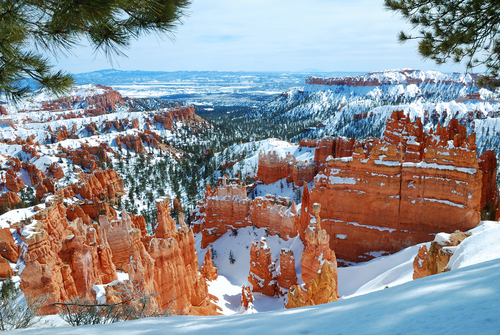
Bryce Canyon is already one of the most unique looking places on earth, but when its distinctive golden rock formations are partially covered in white, this beautiful place looks otherworldly. Surprisingly, Bryce draws few visitors during the winter months, which is a shame, because this place is stunning in the snow. Having said that, the best views might just be at night, when the crisp winter air makes for especially vivid stargazing. For the best experience, join a free ranger-guided snowshoe hike, a fun adventure that doubles as a fascinating astronomy lesson.
Carlsbad Caverns National Park
New Mexico

New Mexico is often blazing hot during the crowded summer months, but in winter it tends to remain a consistent 56 degrees Fahrenheit. As luck would have it, that’s the perfect temperature at which to explore Carlsbad Caverns National Park. This unique park consists of one of the largest cave systems in the world, and visitors can explore the impressive caverns on fascinating guided tours. Above ground, the Chihuahuan Desert includes neat sights like the White Sands National monument, and small historic towns known for their artists and spas.
Death Valley National Park
California

Maybe it’s fair to say that winter is the only time to visit Death Valley National Park. Unlike the summer, when local temperatures rise past 120 degrees Fahrenheit, winter in Death Valley brings mild weather and average temperatures around 70. The massive national park has everything from snow-covered peaks to golden sand dunes, both of which make this a killer spot for photography buffs. If you plan to stay overnight — as is highly recommended — be sure to make reservations as far in advance as possible. The winter months tend to be busy.
Denali National Park
Alaska
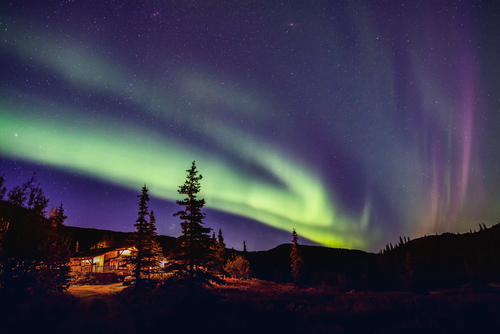
Granted, it’s snowy and wintery feeling for most of the year, but Denali National Park is one of earth’s most stunning spots come true winter. If you’re visiting after winter solstice, expect fewer than five hours of daylight per day. That may sound like it leaves little time for ranger-led snowshoe walks, skiing, and dog sledding, the latter of which is surprisingly popular around these parts. Don’t worry about the lack of daylight. Night time at Denali comes with the breathtaking show that is the aurora borealis. If you can, time your winter trip to Denali to catch February’s week-long Winterfest.
The Grand Canyon
Arizona
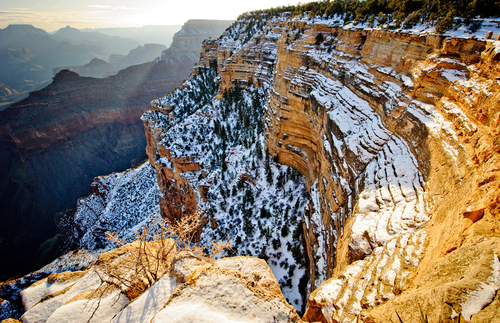
Visiting the Grand Canyon in winter comes with at least one major perk: the reservations that are usually required long in advance during the warmer months are unnecessary during the winter. It’s shocking how few people make the trek to the world’s most famous canyon during the winter. For those who do decide to go, the South Rim is more easily accessible this time of year, and closer to Phantom Ranch, where you can have your choice of once-in-a-lifetime hikes, horseback riding tours, and cycling adventures. Don’t let the snow-capped canyon deter you. The temperatures towards the bottom of the canyon are surprisingly balmy this time of year, averaging between 50 and 60 degrees Fahrenheit.
Great Smoky Mountains National Park
North Carolina and Tennessee

The most visited national park in the United States is just as beautiful in the winter as it is during the spring, summer, and fall. Though you won’t catch sight of any of the park’s famous bear residents, other animals are easy to spot along the trails. Snow in North Carolina and Tennessee is never guaranteed, but the park’s trees are often covered in so much ice the region begins to resemble Narnia. Bring your hiking gear to hit the trails, including the part of the Appalachian Trail that runs through the Smoky Mountains.
Lassen Volcanic National Park
California
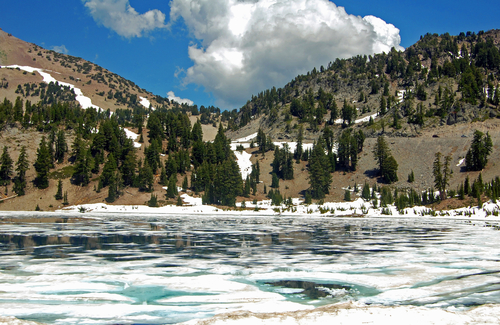
You might have to work a little harder to get there, but Lassen Volcanic National Park is one of the best national parks to visit during the winter. Some of the usual roads leading into the park close after the first snowfall, but once you’re there, enjoy sledding hills with killer views, snowshoeing, and backcountry ski slopes for skiers of all experience levels. However you choose to enjoy Lassen, don’t forget to stop every once in a while and take in the smoky natural steam vents, the iced-over lakes, and of course, the snow-capped titular volcano.
Mesa Verde National Park
Colorado

Over 600,000 people visit Mesa Verde National Park each year, but amazingly, the average winter day sees only 50 visitors! The national park, which is famous for the thousands of ancient Native American cliff dwellings preserved by the rocky landscape, has a fantastic Archeological Museum which is open year round. Visitors hoping to get in some hiking will love Petroglyph Trail and the 6-mile Mesa Top Loop Road, the latter of which ends with stunning views. Cliff Palace Loop Road is ideal for snowshoers, and visitors can even rent snowshoes from the visitor center.
Mount Rainier National Park
Washington
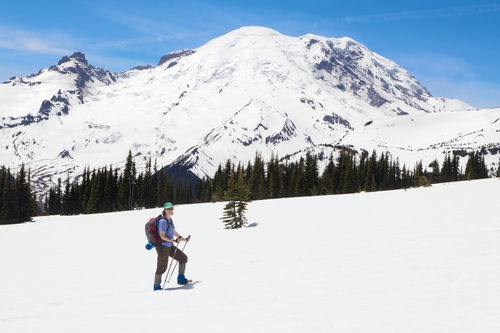
Winter adventurers will revel in the experience of visiting Mount Rainier National Park during this time of year. Though it requires some planning (fewer roads and hotels are open), Mount Rainier offers an impressive number of snow activities. As the park averages about 54 feet of snow annually, skiing and sledding are world-class from about December thru March. The park also allows backcountry camping, though rangers require campers to stay within 300 feet of all trails and buildings.
Rocky Mountain National Park
Colorado

Imagine standing in a valley with more than 60 snow-capped mountain peaks towering above you. That’s the sight you’ll experience when you visit Colorado’s Rocky Mountain National Park during the winter. The cold weather doesn’t seem to keep too many people from enjoying this slice of heaven on earth. Indeed, people come from all over the world to go winter mountaineering, snowshoeing, skiing, and ice-climbing in the park. Though the mountains here are prone to avalanches, Rocky Mountain National Park remains one of the few that allows winter camping. If pitching a tent in the snow and sleeping under the winter sky is on your itinerary, just be sure to grab a free backcountry permit and check in with a park ranger.
Yellowstone National Park
Idaho, Montana, and Wyoming

This one isn’t for the faint of heart. Massive Yellowstone National Park, which spans into three states. It really packs in the snow during the winter months, making it a destination best saved for the most adventurous of us. But if you can hack it, you surely won’t be disappointed. Yellowstone’s many hot springs, fumaroles, and geysers are always dramatic, but they’re even more impressive against the stark white backdrop of the snow-covered landscape. Cross-country skiing trails are some of the best you’ll find anywhere. Snowshoe and snowmobile tours can be booked through the park with a guide and there’s access to warming huts conveniently located along the trail.
Yosemite National Park
California
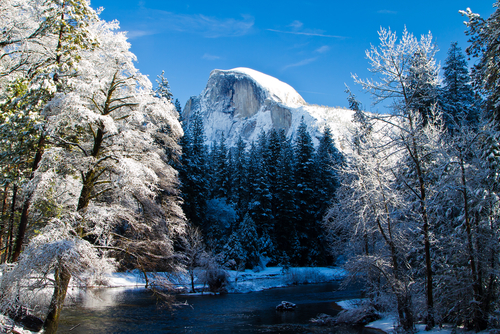
You haven’t seen Yosemite National Park until you’ve seen Half Dome covered in snow. If you’re visiting Yosemite to relax, simply book a room at the classic Awhaahnee Hotel, open all year round, and snuggle up by the grand fireplace as you watch the snow fall outside. If adventure is more your style, Yosemite has that, too. The 21-mile trail to Glacier Point is closed to cars but open to cross-country skiers and snowshoers. And while the challenging trip can be done in a day, we think it’s more fun to break it up with a night spent camping under the winter sky.
Zion National Park
Utah

Of all the benefits of visiting Zion National Park in the winter, the best may be the fact that private vehicles are allowed on the Scenic Drives that are open to only tour buses during the busy summer months. This makes sightseeing in this stunning national park a breeze. Awe over the narrow slot canyons, the red sandstone cliffs, and the waterfalls that cascade into streams and springs. Cool temperatures make hiking the unique landscape a much nicer prospect, and if you can stay a few days (trust us, you’ll want to!), the normally packed Zion Lodge offers big discounts to winter visitors.
